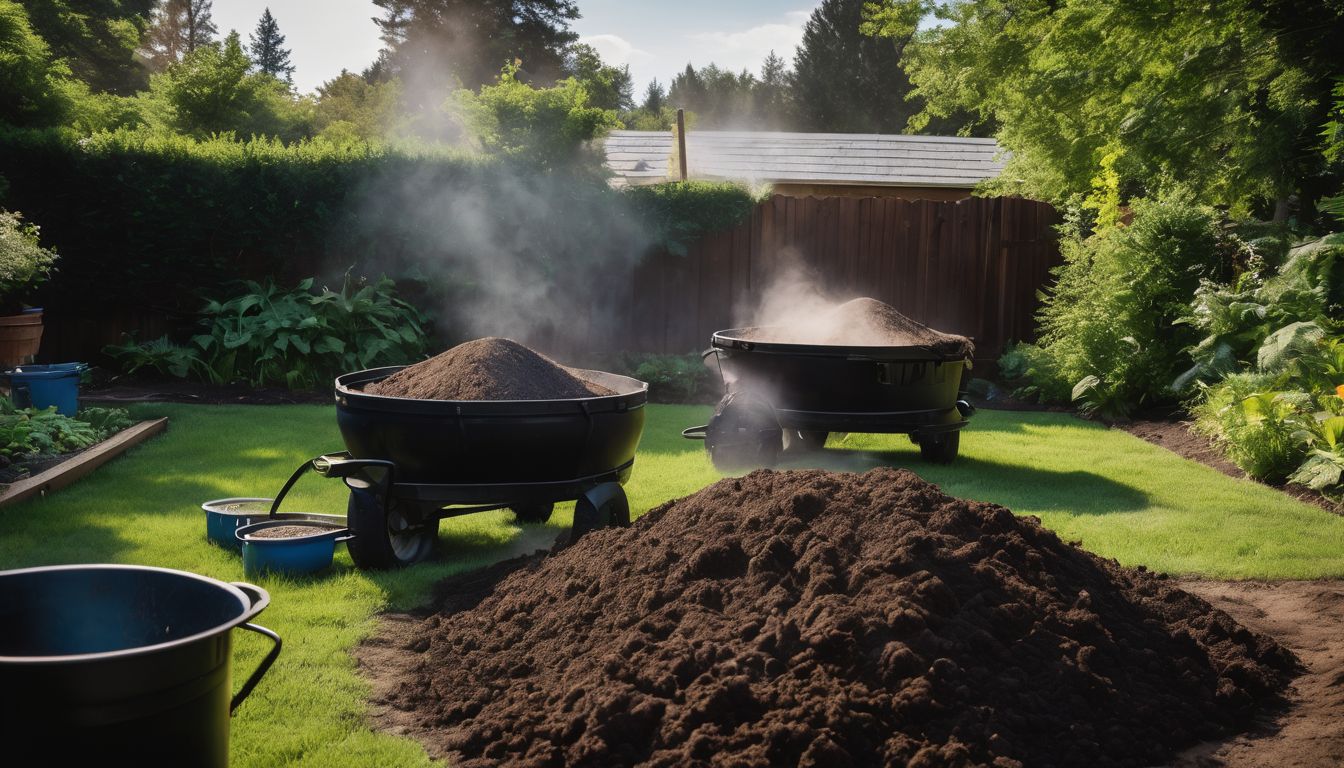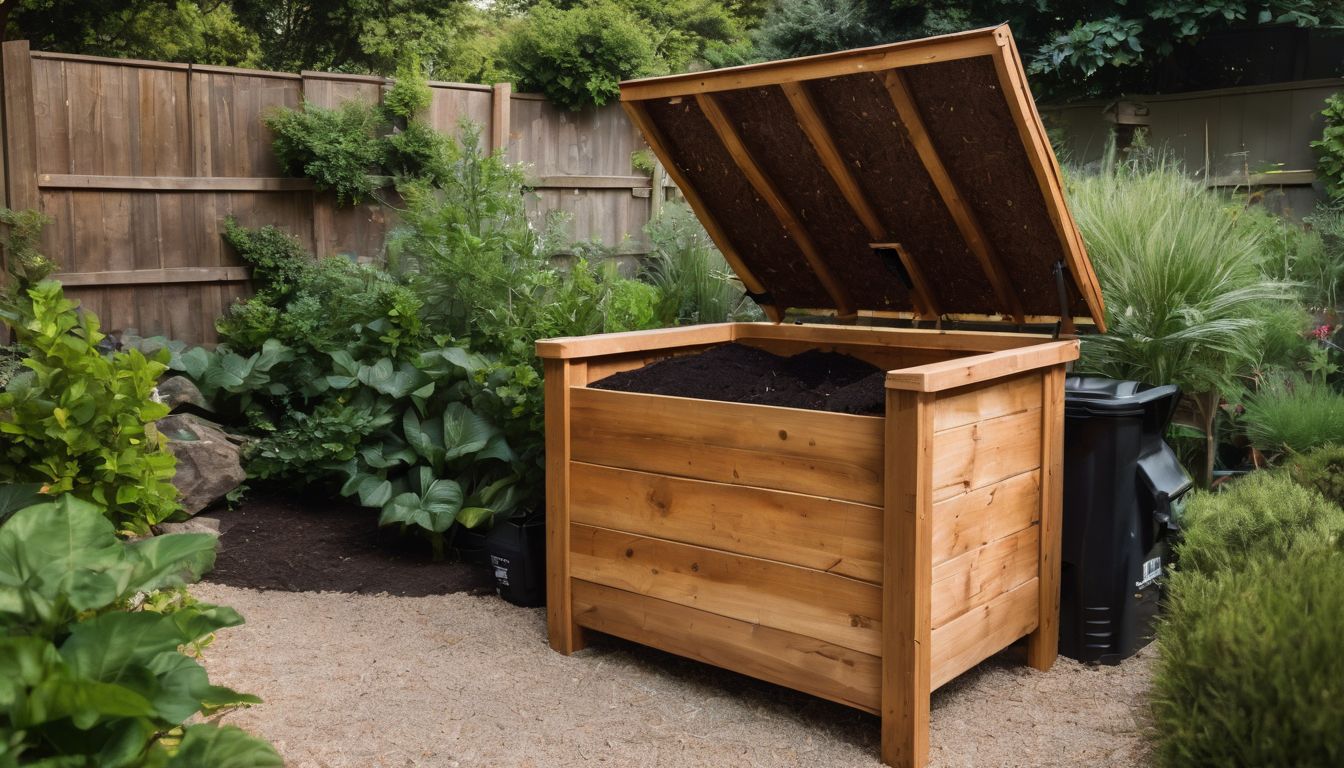Many of us are searching for ways to reduce our household waste and make a positive environmental impact. Composting transforms kitchen scraps and garden clippings into nutrient-rich soil, marrying sustainability with practicality.
This blog will guide you through the fascinating science behind composting, equipping you with knowledge to turn your organic waste into garden gold effortlessly. Discover how a simple pile of leftovers can rejuvenate the earth!
Key Takeaways
- Composting is a natural process where microorganisms break down organic material into nutrient-rich soil. It can be aerobic with oxygen or anaerobic without, but the former is quicker and more efficient.
- Essential factors for successful composting include the right balance of nutrients, proper material composition and size, optimal temperature and moisture levels, along with sufficient oxygen and neutral pH levels.
- The benefits of composting extend beyond soil health improvement; it reduces waste in landfills, conserves resources by lessening reliance on chemical fertilisers, and promotes sustainability through lowering greenhouse gas emissions.
The Basics of Composting
Compost is a nutrient-rich, dark, organic material that occurs when microorganisms decompose organic matter in the presence of oxygen. This can happen aerobically, with the aid of oxygen, or anaerobically, without it.
What is compost?
Compost is a rich, nutrient-dense substance created from the decomposed organic matter. Gardeners and farmers prize it for its ability to enhance soil structure, provide essential nutrients to plants, and improve overall soil fertility.
Leaves, vegetable scraps, fruit peelings, and grass clippings often make up this green waste that undergoes biological changes through microbial activity.
This natural process mimics how matter breaks down in the wild. Microorganisms such as bacteria and fungi play a critical role by breaking down this organic material into humus – a dark brown part of the earth’s topsoil holding important nutrients for plant growth.
By adding compost to gardens or agricultural fields, you help reduce dependency on chemical fertilisers while also diverting waste from landfills where it would release harmful greenhouse gases as it decays without oxygen in an anaerobic process.
Through thermophilic composting—a high-heat aerobic process—compost can reach temperatures that destroy weed seeds and harmful pathogens ensuring that only beneficial substances are returned to the earth.
How does it happen?
Composting happens through the breakdown of organic matter by microorganisms. This process involves chemical changes, physical changes, and decomposition. As bacteria and fungi break down the materials, humic substances are formed, enriching the compost with vital nutrients for soil health.
The temperature, moisture levels, oxygen, and pH balance play key roles in supporting the activity of these microorganisms.
The breakdown of organic matter releases valuable nutrients such as nitrogen, phosphorus, and potassium into a nutrient-rich mixture that benefits plants when added to soil. By understanding this natural process and creating ideal conditions for it to occur efficiently, environmentally conscious individuals support conservation efforts by reducing waste and promoting sustainability.
Aerobic vs. anaerobic composting
Aerobic composting occurs in the presence of oxygen. This method involves turning or agitating the compost pile, allowing air to circulate and providing an environment for aerobic microorganisms to break down organic matter efficiently.
On the other hand, anaerobic composting takes place without oxygen and typically is slower than aerobic composting. Anaerobic decomposition can produce unpleasant odours due to the release of methane gas, which has a higher impact on global warming than carbon dioxide.
In aerobic composting, microorganisms use oxygen to decompose organic materials effectively, producing heat as a byproduct. In contrast, anaerobic decomposition produces less heat and requires a longer time for breakdown.
The Three Phases of Composting
After the initial decomposition phase, where organic materials break down and heat up, comes the active decomposition phase. This is when microbes really get to work breaking down the materials.
Finally, there’s curing and maturation, where the compost finishes decomposing and becomes nutrient-rich soil amendment.
Initial decomposition
During the initial decomposition phase, organic matter starts to break down. Microorganisms like bacteria and fungi begin to digest the materials and release carbon dioxide as a byproduct.
This stage is crucial for setting the foundation of the composting process, as it kickstarts the breakdown of complex compounds into simpler forms that can be further decomposed.
As microorganisms feed on organic matter, they generate heat which accelerates the breakdown process. The temperature inside the compost pile rises during this stage, creating an environment that supports microbial activity, such as beneficial bacteria breaking down complex substances into simpler molecules.
Active decomposition
Transitioning from initial decomposition to active decomposition, this phase is characterised by increased microbial activity and rising temperatures within the compost pile. Microorganisms such as bacteria and fungi work tirelessly to break down organic matter, releasing heat as a byproduct of their metabolic processes.
This rise in temperature accelerates the breakdown of materials, leading to the rapid transformation of waste into valuable soil amendments rich in nutrients.
The heightened microbial activity during active decomposition also helps to suppress harmful pathogens and weed seeds, further contributing to the creation of nutrient-rich compost while reducing its carbon footprint.
Curing and maturation
During the curing and maturation phase, the compost continues to break down. This process occurs at a slower rate than active decomposition. Organic matter further decomposes, allowing for the development of a stable and nutrient-rich soil amendment.
As the compost cures and matures, it becomes increasingly beneficial for enriching soil with essential nutrients. The final product is a dark, crumbly substance that improves soil structure and fertility.
Moving on to “The Role of Microorganisms in Composting”..
The Role of Microorganisms in Composting
Microorganisms such as bacteria, fungi, and physical decomposers play a crucial role in breaking down organic matter during the composting process. Curious about how these tiny organisms work their magic? Keep reading to find out more!
Bacteria
Bacteria play a crucial role in the composting process, breaking down organic matter into nutrient-rich soil. They thrive in aerobic conditions and kick-start the decomposition phase by consuming simple sugars and proteins.
As they multiply, their activity generates heat, accelerating the breakdown of materials.
Additionally, bacteria help to regulate pH levels within the compost pile, ensuring an environment conducive to further microbial activity. With the help of these tiny organisms, decomposition continues, gradually transforming raw organic matter into valuable compost for enriching soil and supporting plant growth.
Fungi
Fungi play a crucial role in the composting process, breaking down tough materials like cellulose and lignin. They help to decompose organic matter and work alongside bacteria to break down complex compounds, releasing nutrients that enrich the compost.
Fungi thrive in aerobic conditions and help maintain a healthy balance within the compost ecosystem, contributing to its overall nutrient-rich composition.
As active decomposers, fungi are essential for effective composting, aiding in the breakdown of plant material and ensuring the creation of high-quality nutrient-rich soil amendments.
Physical decomposers
Physical decomposers such as earthworms, insects, and other small organisms play a crucial role in breaking down organic matter during the composting process. These creatures physically break down the materials by shredding and consuming them, which aids in accelerating the decomposition process.
Earthworms, for example, burrow through the compost pile, creating passageways that help aerate the mixture and facilitate microbial activity. Insects like beetles and springtails also contribute to decomposition by feeding on decaying material and assisting in nutrient cycling within the compost.
These physical decomposers enhance nutrient cycling within the compost pile, contributing to its overall richness while improving its structure. Through their actions, they transform complex organic compounds into simpler forms easily accessible to microorganisms.
Key Factors for Successful Composting
Nutrients, material composition, temperature, moisture levels, oxygen and pH are all crucial factors in successful composting. It’s important to understand how these elements work together to create nutrient-rich compost for your garden or farm.
Nutrients needed
Composting requires a mix of essential nutrients to support the growth and activity of microorganisms. These include carbon, nitrogen, phosphorus, potassium, calcium, magnesium, and sulphur.
Carbon-rich materials like leaves and straw provide energy for the microorganisms’ metabolism while nitrogen-rich materials like kitchen scraps and grass clippings supply protein for cell development.
Phosphorus aids in DNA formation, potassium regulates water balance within cells while calcium strengthens cell walls.
Microorganisms also require magnesium for chlorophyll production essential for photosynthesis and sulphur for the synthesis of certain amino acids crucial in protein formation. Maintaining this nutrient balance encourages efficient composting processes resulting in high-quality organic fertiliser that enriches soil health.
Material composition and size
After ensuring the right nutrients for your compost, considering material composition and size is vital to successful composting. The ideal size of organic materials for efficient decomposition ranges from small particles to larger chunks.
Balancing the ratio of green to brown materials is crucial for a nutrient-rich mix.
Aerate your pile by turning it regularly with a pitchfork or shovel, allowing oxygen to fuel the decomposition process. Moreover, an optimal balance between carbon and nitrogen is essential in creating a healthy environment for microorganisms.
Temperature and moisture levels
Temperature and moisture levels play a crucial role in the composting process. The ideal temperature range for composting falls between 110°F to 160°F, as this allows microorganisms to thrive and break down organic matter effectively.
Maintaining adequate moisture, typically around 50-60%, is vital for microbial activity. If the pile is too dry, decomposition slows down, but if it’s too wet, oxygen flow is restricted.
A balanced moisture level ensures that the beneficial bacteria and fungi have the necessary environment to decompose materials efficiently. Monitoring these factors throughout the composting process is essential for producing high-quality nutrient-rich compost.
Oxygen and pH levels
To support the composting process, adequate oxygen levels are crucial. Oxygen allows aerobic microorganisms to thrive and break down organic matter efficiently. By turning or aerating the compost pile regularly, you can ensure a healthy oxygen supply for these beneficial organisms, aiding in the decomposition process.
Moreover, maintaining an optimal pH level between 5.5 and 8 is essential for microbial activity during composting. This balanced pH environment promotes the growth of bacteria and fungi that contribute to nutrient-rich soil production.
In addition to sufficient oxygen levels, keeping a close eye on pH levels throughout the composting journey is necessary for creating high-quality compost rich in nutrients and beneficial microorganisms.
The Benefits of Composting
Composting improves soil health, reduces waste, conserves resources, and promotes sustainability. Read more to discover the many advantages of composting for our environment and communities.
Improves soil health
Composting enriches soil by adding essential nutrients and improving its structure. The nutrient-rich compost acts as a natural fertiliser, providing the necessary elements for plant growth and enhancing soil vitality.
By incorporating compost into the soil, it promotes microbial activity, which contributes to healthier and more productive vegetation.
Furthermore, compost helps to retain moisture in the soil, reducing the need for additional watering. This water retention capacity is especially beneficial during dry periods or in regions prone to droughts.
Reduces waste
After improving soil health, composting also reduces waste. Food scraps, yard trimmings, and other organic materials make up about 30% of what we throw away. Composting these items instead of sending them to the landfill not only prevents the generation of harmful greenhouse gases but also reduces the strain on already limited landfill space.
Composting diverts organic waste from landfills where it decomposes without oxygen, creating methane. Methane is a potent greenhouse gas that contributes to climate change. By composting at home or through local programs, you can significantly reduce your household’s contribution to this unnecessary pollution.
Conserves resources
When composting, you conserve resources by diverting organic waste from landfills. This reduces the need for transportation and the energy required to process and dispose of waste.
Composting also lessens the demand for chemical fertilisers, as nutrient-rich compost can be used to enrich soil, promoting healthier plant growth without depleting natural resources.
By composting at home or within your community, you actively contribute to resource conservation, creating a sustainable cycle that benefits both the environment and future generations.
Promotes sustainability
By reducing the amount of waste that ends up in landfills, composting promotes sustainability. Nutrient-rich compost enriches soil, reducing the need for chemical fertilisers and promoting healthy plant growth.
This process also helps to conserve resources and reduce greenhouse gas emissions, contributing to a more sustainable environment.
Conserving resources and promoting sustainability through composting can have a positive impact on the environment by decreasing reliance on harmful chemicals and minimising carbon footprint.
Conclusion
Understanding the science behind composting helps us appreciate its role in enriching soil. The active involvement of microorganisms and key factors influence the success of composting.
Embracing this process promotes sustainability, reduces waste, and supports environmental conservation efforts. Composting is a simple yet impactful way to contribute to a healthier planet for future generations.
FAQs
1. What is ‘The Science Behind Composting’ all about?
‘The Science Behind Composting’ explains how composting works and the chemistry involved in breaking down organic materials into nutrient-rich soil.
2. Why is composting good for my garden?
Composting turns kitchen and garden waste into a nutrient-rich substance that helps plants grow strong and healthy.
3. Can I make compost at home?
Absolutely! With some basic knowledge of the science behind composting, anyone can start turning their household waste into valuable compost for their garden.
4. Does it take long for waste to turn into compost?
The time it takes can vary, but by understanding the chemistry of composting, you can speed up the process to get that rich, nutritious soil faster.





